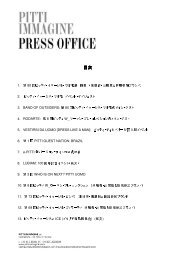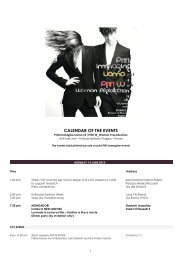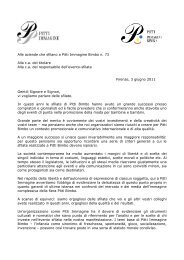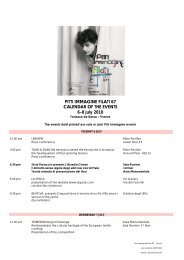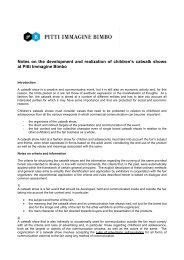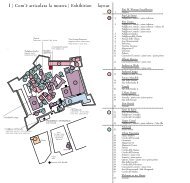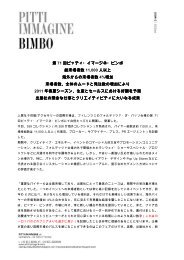Comunicato_libro Walter Albini a MILANO_ING_ok - Pitti Immagine
Comunicato_libro Walter Albini a MILANO_ING_ok - Pitti Immagine
Comunicato_libro Walter Albini a MILANO_ING_ok - Pitti Immagine
Create successful ePaper yourself
Turn your PDF publications into a flip-book with our unique Google optimized e-Paper software.
WALTER ALBINI AND HIS TIMES.<br />
ALL POWER TO THE IMAGINATION<br />
A Fondazione <strong>Pitti</strong> Discovery bo<strong>ok</strong> and project<br />
Edited and curated by Maria Luisa Frisa and Stefano Tonchi<br />
Cover artwork by Francesco Vezzoli<br />
Series Mode, a Fondazione <strong>Pitti</strong> Discovery publication, Marsilio Editori<br />
Friday 26 february 2010 _ from 6.00 pm to 9.00 pm<br />
SPAZIO NILUFAR _ via Spiga 30 _ Milano<br />
On the occasion of the fashion week, the Fondazione <strong>Pitti</strong> Discovery presents in Milan its last monograph<br />
produced within the series Mode: the bo<strong>ok</strong> “All power to the imagination. <strong>Walter</strong> <strong>Albini</strong> and his times”, by Maria<br />
Luisa Frisa and Stefano Tonchi.<br />
“Twenty-seven years old, Pisces”, are the first things <strong>Walter</strong> <strong>Albini</strong> says about himself with a smile. This<br />
designer and stylist […] prefers prêt-à-porter because it moves towards life, because it’s for all women and<br />
helps them not have to sacrifice - let’s say a nice trip for a dress”.<br />
That was how Vogue Italia introduced <strong>Walter</strong> <strong>Albini</strong> in October 1967 and the words allude to the creative power<br />
that would transform WA into the protagonist of the Italian prêt-à-porter revolution. It was the beginning: <strong>Albini</strong>’s<br />
parabola would end soon, too soon, in 1983, but the designer’s personal and creative career contained all the<br />
traits that define those years.<br />
“All power to the imagination. <strong>Walter</strong> <strong>Albini</strong> and his times” reconstructs a period that witnessed the<br />
establishment of fashion as a basic element in representing contemporary society and culture and the definitive<br />
decline of the couture atelier with the rise of democratic fashion with the development of high quality series<br />
production. <strong>Walter</strong> <strong>Albini</strong> was one of the key figures of that period because he was fully aware of the need for<br />
change and innovation – not only in fashion’s form and style, but also in its way of communicating its rituals and<br />
mannerisms. Through the pages of magazines of the day, photographs and original drawings, the bo<strong>ok</strong><br />
captures the essence of the <strong>Albini</strong> style: the Gatsby lo<strong>ok</strong> and a retrieval of the ‘twenties and ‘thirties with postmodern<br />
attitudes; attention to the imagery and settings that surrounded his clothes and became lifestyle<br />
elements; the development of brands – and <strong>Albini</strong> grasped their growing importance and the simultaneous<br />
construction of the <strong>Albini</strong> icon that easily found a place on the international scene with the leaders of the times<br />
such as Halston, Karl Lagerfeld, Yves Saint Laurent, and Ossie Clark.<br />
The bo<strong>ok</strong> is not a chronology of <strong>Walter</strong> <strong>Albini</strong>’s life. Rather, it is a portrait of a designer who, now more than<br />
ever, seems contemporary and current, a source of references for a new generation of fashion designers who<br />
lo<strong>ok</strong> to him as a paragon of pure, crystalline talent, who was able to lo<strong>ok</strong> at the history of fashion to create a<br />
new, revolutionary grammar to break with the past and find unexplored ways of presenting his collections.<br />
His men’s non-collection for the summer of 1979 is crucial in this sense: it was an exhibit with twelve outfits<br />
shown on panels. The clothes he skillfully put together belonged to designer, photographer and journalist<br />
friends: “We have to learn the freedom of dressing outside the box. Consumerism produces objects, not styles. I<br />
lo<strong>ok</strong> around, I choose, I combine and I present”.<br />
With its wealth of images and texts the bo<strong>ok</strong> presents a unique story, a fresco of the years that changed not<br />
only the history of Italian fashions, but the history of Italy as well. <strong>Albini</strong>’s words to Anna Piaggi concerning his<br />
1979 spring/summer collection best convey his creative restlessness and his imaginative strength: “For me,<br />
each outfit tells a story, of love, of anger, of violence. Each one is a moment, a person, a place, and each has a<br />
role, like in a theater. To change clothes you have to change your attitude and spirit, and take on a new role.<br />
Every time, every season, every collection…...”.<br />
Thanks to I SPIRIT VODKA and CIOCCOLATO LA MOLINA
ALL POWER TO THE IMAGINATION<br />
WALTER ALBINI AND HIS TIMES<br />
Edited and curated by Maria Luisa Frisa and Stefano Tonchi<br />
Assistant to the editors Gabriele Monti and Irene Guzman<br />
Cover artwork by Francesco Vezzoli<br />
Texts by : Flavio Albanese, Carlo Antonelli, Gloria Bianchino, Cristopher Breward,<br />
Mariuccia Casadio, Angelo Flaccavento, Maria Luisa Frisa, Gabriele Monti, Ivan<br />
Paris, Simona Segre Reinach, Mauro Tinti, and Stefano Tonchi<br />
Biography and fashion show chronology by Manuela Soldi<br />
225 pages, 500 illustrations.<br />
Italian and English edition<br />
Series Mode, a Fondazione <strong>Pitti</strong> Discovery publication, Marsilio Editori.





